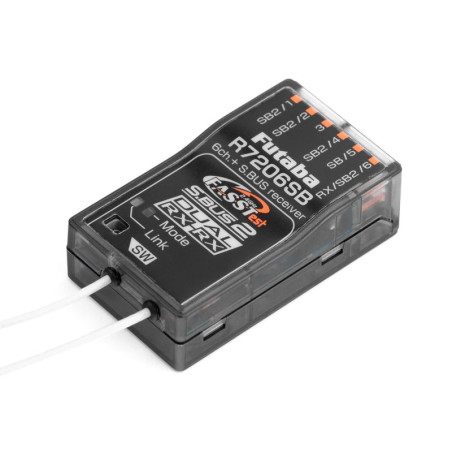


Futaba's six-channel FASSTest-2.4GHz transmission system telemetry receiver with a pair of full-band Diversity antennas. It is designed for general use in models of all categories. Thanks to its compact size, light weight and connectors located in the longitudinal axis, it is also suitable for models with slender fuselages, such as F3B, F3J gliders, etc. Thanks to selectable channel modes and the ability to work with two receivers, it will also be perfect for models requiring a large number of channels - in this case, the R7206SB pair will provide as many as 16 classic PWM channel outputs or 10-12 PWM outputs, S.BUS and S.BUS2 serial outputs for bidirectional communication allowing connection of S.BUS2 servos, telemetry sensors and other compatible devices, as S.BUS2 ports can also support channel slots 1, 2, 4 and 6. Receiver operating states are indicated by an LED.
Transmission system:
Futaba FASSTest-2.4 GHz with telemetry for flying models.
Note that only digital servos can be used in the FASSTest 12CH high repetition rate mode.
Power supply:
3.7-7.4 V (nominal voltage), the operating voltage range is 3.5-8.4 V - that is, for example, 4-6 NiMH, 1-2S LiPo, 2S LiFe and Li-ion batteries, BEC power stabilizers within the given voltage range.
Antenna:
The receiver is equipped with a pair of differential antennas to maximize signal reception regardless of the relative position of the model and transmitter. They should be mounted on the model with a mutual orientation of 90°.
Receiver outputs, channel modes:
The receiver is equipped with sockets for standard Futaba connectors (with a tab), into which, of course, UNI connectors (JR/Graupner, Hitec) without a side projection can also be inserted (be careful not to confuse the polarity).
Channel outputs (PWM/S.BUS/S.BUS2): The R7206SB allows you to reassign channels according to the table in the manual, which allows you to use a combination of classic PWM outputs and S.BUS outputs or dual receiver operation (requires a Futaba transmitter that allows dual receiver operation), in which a pair of R7206SBs can offer up to 12 classic PWM channels or 10-12 PWM outputs and 1-2 S.BUS/S.BUS2 serial outputs, or other combinations with additional S.BUS2 input/output ports. Channel modes are selected using a button on the receiver in a special setting mode - channel modes cannot be changed in normal operation.
Operation with two receivers with automatic backup:
It is also possible to enable two-receiver mode with automatic backup on the receiver, which automatically switches from the main receiver to the backup receiver (or vice versa) in case one of the receivers (a pair of R7206SBs or one R7206SB and another FASSTest S.BUS2 receiver) fails. The function is basically the same as the FDLS-1 backup system, but it can be done without additional equipment.
Telemetry (FASSTest only):
The R7206SB transmits receiver supply voltage data to the transmitter without connecting any sensors.
The R7206SB allows the use of all Futaba telemetry sensors and other sensors compatible with the S.BUS2 bus system with two-way communication.
What is S.BUS2/S.BUS:
S.BUS - Futaba's serial bus with unidirectional communication that allows control of servos, controllers, switches, gyroscopes and other compatible RC devices connected to a single output port of the S.BUS receiver.
S.BUS2 - Futaba's serial bus for bidirectional communication allowing (like S.BUS) control of servos, controllers, switches, gyroscopes and other compatible RC devices connected to a single output/input port of the S.BUS2 receiver. In addition, it allows you to connect telemetry sensors and send data from them through the receiver for display on the transmitter; from some servos, the S.BUS2 can send information about operating current, temperature or servo output lever angle to the transmitter.
Unlike classic RC kits, the S.BUS(2) system uses serial data communication to send control signals from the receiver to the servo, gyro or other device. This data includes commands such as "move channel 3 servo by 15 degrees, move channel 5 servo by 30 degrees" for many devices. S.BUS(2) devices only execute commands belonging to their own set channel. For this reason, it is possible to connect several servos to the same signal cable, setting and controlling them individually as needed. The servo's identification code (ID) is used for this purpose. You can find the ID on a sticker on the servo box.
The S.BUS2 servo can be connected to the receiver's S.BUS2 and S.BUS ports. Its function is determined by setting the channel in the servo's memory (this is done using the programming interface of the Futaba transmitter, the SBC-1 programmer, or the CIU-3 USB interface with the S-Link PC program - for some servos, the channel can only be set using the transmitter).
An S.BUS or S.BUS2 servo connected to the channel output of a classic receiver (PWM) works like a classic servo. Its movement is indicated by a signal in the channel of the receiver to which it is connected. The settings of programmable servo functions remain in effect.
Technical data:
*Follow the instruction manual included with the product.